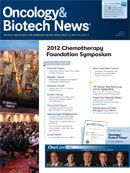Searching for New Pathways and Treatments for Head and Neck Squamous Cell Carcinoma
Scientists now know a lot more about the genetic landscape of head and neck cancer and hope that eventually this knowledge will lead the way to new therapies.
Aaron D. Tward, MD, PhD
Scientists now know a lot more about the genetic landscape of head and neck cancer and hope that eventually this knowledge will lead the way to new therapies, according to Aaron D. Tward, MD, PhD, of the Broad Institute of MIT and Harvard in Cambridge, Massachusetts. Tward described findings of recent collaborative research on the topic at the 2012 Chemotherapy Foundation Symposium.
For this research, Tward, also with the Department of Otology and Laryngology at Harvard Medical School and a clinical fellow in those specialties at the Massachusetts Eye & Ear Infirmary in Boston, and colleagues analyzed tumor samples provided by the University of Pittsburgh from 92 patients with head and neck squamous cell carcinoma (HNSCC). The samples were chosen to be reflective of the normal distribution of patients with these cancers, that is, “mostly men and mostly smokers,” noted Tward. Of these patients, 89% reported a history of tobacco use and 79% alcohol use; 14% of all tumors and 53% of oropharyngeal tumors were found to be positive for human papillomavirus.
Tumor sites also were selected so as to be roughly representative of the general HNSCC patient population; thus, most were oral cavity cancers, followed by a substantial proportion of oropharynx cancer samples, and a few from patients with hypopharyngeal or laryngeal tumors, Tward explained.
Investigators used hybrid capture sequencing to compare tumor tissue with nontumor tissue from the same individual. They also compared the total number of mutations in the HNSCC samples with samples from previous tumor studies done at Broad. Tward noted that HNSCC clusters with lung cancer, in that both possess a relatively high number of mutations, sometimes referred to as “the smoking cluster.”
The analysis yielded a very large number of mutations; for example, 5000 genes had at least one mutation, and 1300 had at least two. Tward emphasized, however, that most of these are not implicated either in promoting or maintaining the cancer. “The vast majority,” he said, “are what we call ‘passengers,’ that is, mutations alongside another mutation that is acting as a ‘driver.’” Tward said his colleagues at Broad have developed a set of algorithms to help researchers distinguish between the two.
Analysis using these algorithms confirmed earlier findings implicating TP53, CDKN2A, PTEN, PI3KCA, and HRAS in head and neck malignancies. Of particular interest, however, are mutations they discovered that have not previously been implicated in these cancers: TP63, IRF6, MED1, and, notably, NOTCH.
Tward explained that NOTCH, depending on the cell in which it resides, can act either as an oncogene (as is the case with acute lymphoblastic leukemia) or as a tumor suppressor gene in HNSCC and skin cancer; in these cancers, NOTCH is “a critical player in the decision to stop proliferating,” he continued. When mutations inactivate NOTCH, terminal differentiation ceases, causing unrestrained proliferation. To illustrate the challenge posed by NOTCH’s dual mechanisms, Tward noted a clinical trial testing a gamma secretase inhibitor predicted to inhibit NOTCH in patients with Alzheimer’s disease that had to be stopped because the drug was causing an increase in squamous cell cancers in the treatment arm.
The researchers also found that mutations in genes at the “top of our rank list” for head and neck cancers and defects in squamous differentiation also are present in patients with cleft palate syndromes. “We think this is all related,” said Tward.
“When we add all this up, we come up with wiring patterns in head and neck cancer,” which can be used to inform further studies. He added that researchers did not find many oncogenes in these tumor samples, an exception being PI3KCA. Tward suggested that trials with PI3K inhibitors are likely to be fruitful in patients with HNSCC, but “only for those who have the mutation.” He also noted that investigators did not find EGFR mutations, a finding consistent with the much larger Cancer Genome Atlas (TCGA) data set.
Stransky N, Egloff AM, Tward AD, et al. The mutational landscape of head and neck squamous cell carcinoma. Science. 2011;333(6046):1157-1160.




